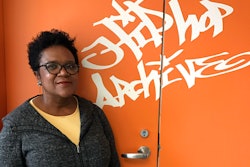Before she earned a masters and a Ph.D., before she became a full professor and a dean, before she published the book that sums up her life's work and her life experience, Terah Venzant Chambers was shaking in a pew. It was Convocation Day at Carleton College in Minnesota, and Chambers, then a freshman, gazed around Skinner Memorial Chapel, with its high stone walls and stained-glass windows.
“It was like a sea of whiteness. There were so few Black students,” said Chambers. “And I just felt like there was a spotlight on me saying, ‘She’s not supposed to be here. She’s an imposter. Who let her in this space?’”
It was a feeling that had roots reaching back to grade school.  Dr. Terah Venzant Chambers
Dr. Terah Venzant Chambers
“[Being a] smart Black girl made me weird,” she said. “There weren’t any other students like me in my classes and we didn’t have teachers who looked like us.”
When Chambers got into Carleton, a classmate told her that it was probably because of affirmative action.
“And I remember thinking like, probably, yeah,” she said.
Imposter syndrome plagued Chambers throughout her freshman year.
“My grades were fine, but I felt like if I slipped a little bit, if I took an hour off, I was going to fail,” she said. “I would read and re-read chapters; I would take notes, and I would take notes on my notes. At the end of the year, I just couldn’t do it anymore.”
Although she had a 3.3 GPA, Chambers decided to transfer to the University of Minnesota. But what Chambers experienced became the foundation of her work as a scholar. Today, Chambers recognizes her feelings as part of the racial opportunity cost that she was forced to pay in order to get her education. It’s a concept that she’s been refining for 16 years, culminating in the release of Racial Opportunity Cost, her first book, this month.
In economics, an opportunity cost is the loss of potential gain from alternatives when a choice is made. If you buy a car, you can’t spend that money on a vacation. If you decide to buy a house, you can’t use that money to start a business. Racial opportunity cost represents the trade-offs that high-achieving minoritized students must make to succeed in white-normed spaces like American schools. It’s what they sacrifice by choosing to further themselves academically and the burdens that come with those choices.
Chambers describes three main types of racial opportunity costs. There are psycho-social costs, like Chambers experienced in college. In addition to not feeling smart enough, like she did, minoritized students may also feel lonely and isolated from the majority community that surrounds them.
Minoritized students also bear community costs, feelings of disconnection from others of their background. Chambers’ research subjects described feelings of distance from peers of their own racial background, a sense of not having much in common. Feelings of disconnection can also occur in families. Chambers remembers being told by an aunt that she would not be able to find anyone to marry if she continued in graduate school and that, if she did, he wouldn’t be Black.
There are also representation costs—the burdens that come with being the only member of a minoritized group in a given setting. This places extra responsibilities on those students—the burden of representing their group well and the burden of serving as proof that a setting is diverse.
“A lot of times, it would be, ‘Oh, we have some visitors coming to the school. Why don’t you Black students take them on a tour?’” said Chambers.
There can also be a constant sense of being on display. In her research, Chambers describes a student who, after picking up a pencil that she had dropped on the floor, said ‘It ain’t broke.’ Her white classmates made fun of her African American Vernacular English, and she developed a sense of needing to be on guard about the way that she spoke.
“There are a lot of ‘high achieving’ Black and Latinx students who are navigating school well and who by all metrics are successful, but at what cost?” said Chambers. “Existing literature really didn’t address this. This is a significant issue that higher education scholars need to understand because it’s underlying a lot of mental health issues.”
Racial opportunity costs can also lead to a sort of self-fulfilling prophecy around minoritized students. Teachers and administrators may think that there are so few minoritized students in elite educational spaces because they cannot handle the work, when, in actuality, the very fact that there are so few prevents others from joining them.
“This sort of absolves school leaders and teachers from taking responsibility,” said Chambers. “[It’s] a really gross simplification of the issue and a little bit of gaslighting in there, too. More students would be able to take those classes and be successful if they didn’t have to diminish who they are so significantly.”
For students who do try to exist in elite educational spaces, racial opportunity costs can affect their academic performance. And, as in Chambers’ case, it can cause them to leave institutions entirely. After graduating from the University of Minnesota, Chambers had no plans for further education.
“I felt like I was probably going to just work at State Farm,” she said. “I was done with school. It was traumatizing for me. [But] I had a mentor who said, ‘That’s why I think you need to go to grad school and study these issues, so that you can help people.’”
Chambers reluctantly applied to the University of Illinois—her mentor’s alma mater. She was accepted and offered a full fellowship, but still didn’t want to go.
“[My mentor] was like, ‘You are so stupid. You cannot turn down a full-ride fellowship,” said Chambers.
The mentor drove Chambers nine hours to campus.
“She set up this whole itinerary for me,” said Chambers. “I remember that breakfast was the first thing that we did. And I come in for breakfast and there are like 15 Black and Latinx students sitting there getting ready to order. And I was like, wait a minute...I was not prepared for that.”
Chambers signed up for a dual masters-Ph.D. program, setting her on a path that led to her breakthrough idea. Racial opportunity cost wasn’t just her academic focus—it was a way of illuminating her own experiences. “I’ve been trying to make sense of this for my whole educational career,” she said.
As Chambers refined the theory and published paper after paper about students who suffered in some of the same ways that she had, she climbed higher in academia than she would have ever imagined, becoming a full professor and associate dean for equity and inclusion at Michigan State University. She teaches at Carleton every summer. Chambers became the Black instructor that she needed to see as a student, and she hopes that Racial Opportunity Cost can help teachers and administrators better support students like her.
But despite all of her accomplishments, Chambers still carries some of the burdens that she shouldered in her school days.
“The self-doubt comes in,” she said. “It comes back to representation costs. I can never just be Terah. I am always Black Terah. And so, if I fail, it's not ever just me. It’s also like a tally mark against Black folks. It’s deeply personal, it’s absolutely racialized, and it’s a set of expectations that I would be devastated not to meet for my community. It would be devastating if I got this wrong.”
It doesn’t look like Chambers has gotten it wrong, however. Shortly after its release, Racial Opportunity Cost was nominated for the American Educational Research Association’s Outstanding Book of the Year Award.
Although some doubts may linger, Chambers’ success is becoming harder and harder to ignore.
“It feels good for me,” she said. “It feels good for little 17-year-old Terah, this part of me doubting whether she was really capable of getting into Carleton or if it was just an affirmative action decision. To make it to this point is just amazing. It’s deeply validating. I’m so proud.”
Jon Edelman can be reached at JEdelman@DiverseEducation.com.















